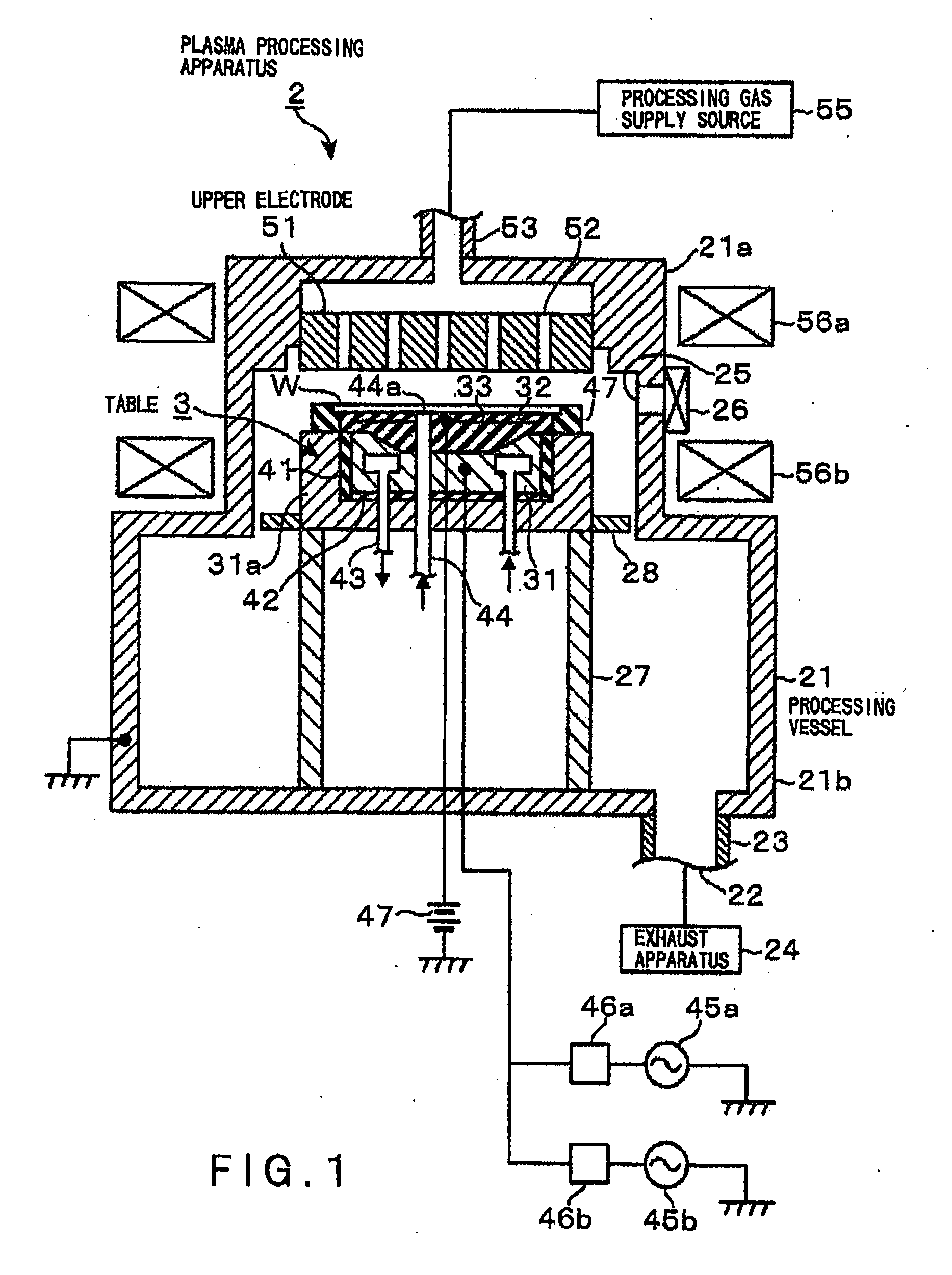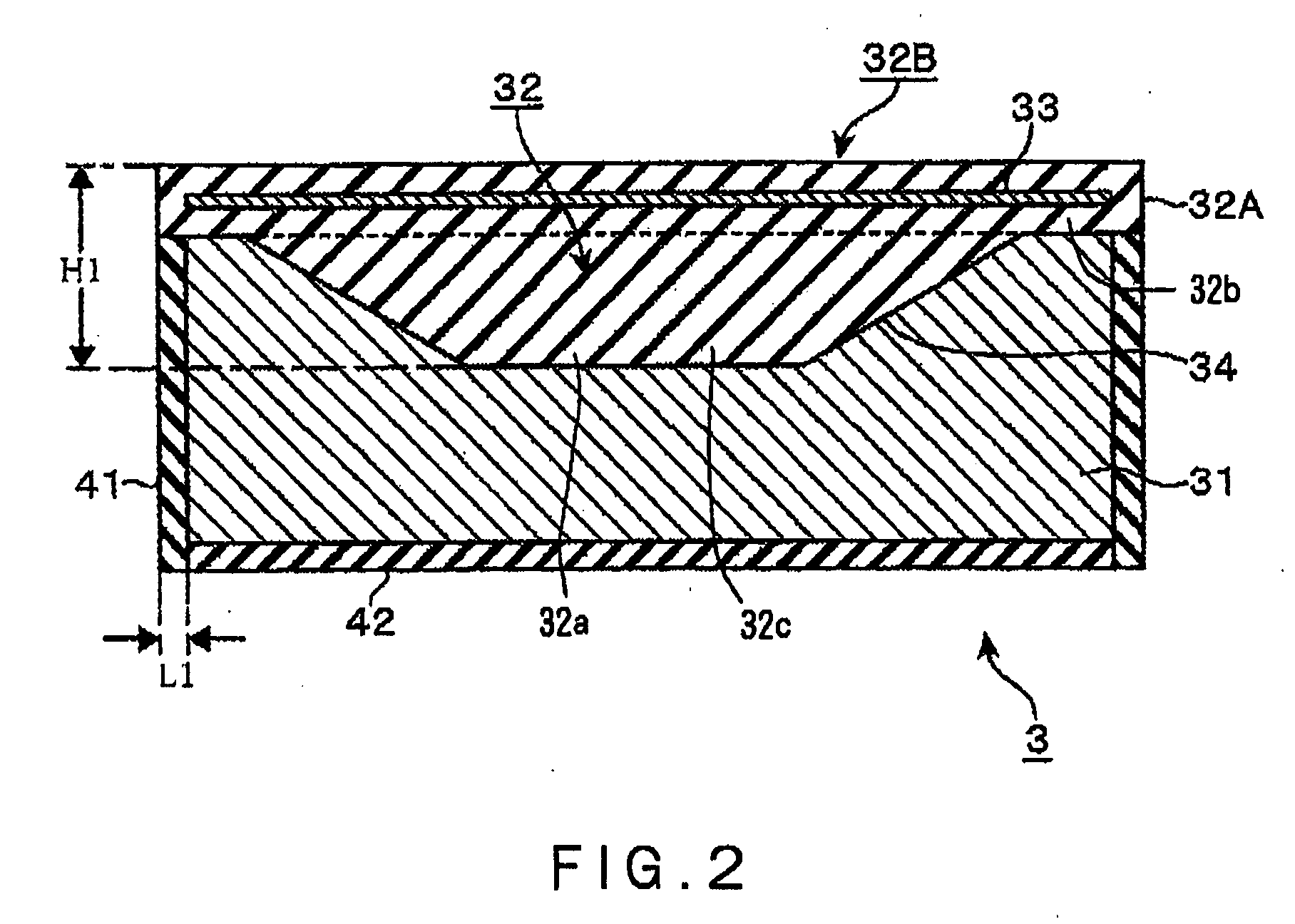Table for plasma processing apparatus and plasma processing apparatus
a plasma processing apparatus and plasma technology, applied in the direction of chemical vapor deposition coating, electric discharge tubes, coatings, etc., can solve the problems of difficult to cover such holes with alumite, difficult to provide a result of the process excellent in the in-plane uniformity, uneven electron density of generated plasma, etc., to avoid or suppress the damage of the electrostatic chuck, the effect of suppressing the stress on the electrostatic chuck
- Summary
- Abstract
- Description
- Claims
- Application Information
AI Technical Summary
Benefits of technology
Problems solved by technology
Method used
Image
Examples
first embodiment
[0053]Next, the table 3 will be described in more detail with reference to FIG. 2. In a longitudinal side sectional view of the table 3 shown in FIG. 2, the coolant passage 42, back-side gas through-holes 43 and the like are omitted for convenience.
[0054]The lower electrode 31 has, for example, a circular shape, and its circumferential face is covered with the insulating member 41, as described above. The insulating member 41 is formed from, for example, alumite, or from ceramic formed by spraying. A thickness of the insulating member 41, as shown by L1 in the drawing, is, for example, 50 μm, in the case in which the insulating member 41 is formed of alumite, while, for example, several hundred microns, in the case in which it is formed of ceramic. The insulating member 42 covering the bottom face of the lower electrode 31 is composed of, for example, alumite.
[0055]In the top face of the lower electrode 31, an inverted frustum-shaped or cone-shaped recess 34 of a size smaller than t...
second embodiment
[0065]Next, a second embodiment of the table for use in the plasma processing apparatus 2 will be described with reference to FIG. 5. The table 6 shown in FIG. 5 includes the lower electrode 31 similar to that of the table 3 discussed above. In the top face of the lower electrode 31, the recess 37 as described above is provided. On the lower electrode 31, a first circular dielectric layer 61, which corresponds to the insulating material portion described in the above embodiment, is arranged for providing uniformity of the electron distribution density of the plasma over the wafer W. The dielectric layer 61 is fixedly attached onto the lower electrode 31 via an adhesive 62. The dielectric layer 61 includes a projection 61c, which projects downward to cover the whole top face of the lower electrode 31 and is formed such that its thickness becomes gradually greater as one moves from its peripheral portion 61b toward its central portion 61a. In this manner, the dielectric layer 61 is fi...
third embodiment
[0075]Next, a third embodiment of the table will be described with reference to FIG. 10(a). The table 8 includes the lower electrode 31 and the insulating members 41, 42, in the same manner as the table 3 of the first embodiment. However, the surface of the lower electrode 31 is not provided with the recess, but is formed to have a flat face. In addition, a flat column-like dielectric layer 81 is provided on the lower electrode 31 such that it covers the lower electrode 31. FIG. 10(b) is a view of the dielectric layer 81 when it is viewed from above. As shown in the drawing, the dielectric layer 81 is composed of a circular dielectric member 82 provided in a central portion, and annular dielectric members 83, 84 respectively provided to surround the dielectric member 82. The dielectric members 83, 84 have diameters different from each other, and are arranged concentrically with the center of the dielectric member 82, respectively. These dielectric members 82 to 84 are formed, by the...
PUM
| Property | Measurement | Unit |
|---|---|---|
| volume resistivity | aaaaa | aaaaa |
| frequency | aaaaa | aaaaa |
| dielectric constant | aaaaa | aaaaa |
Abstract
Description
Claims
Application Information
 Login to View More
Login to View More - R&D
- Intellectual Property
- Life Sciences
- Materials
- Tech Scout
- Unparalleled Data Quality
- Higher Quality Content
- 60% Fewer Hallucinations
Browse by: Latest US Patents, China's latest patents, Technical Efficacy Thesaurus, Application Domain, Technology Topic, Popular Technical Reports.
© 2025 PatSnap. All rights reserved.Legal|Privacy policy|Modern Slavery Act Transparency Statement|Sitemap|About US| Contact US: help@patsnap.com



